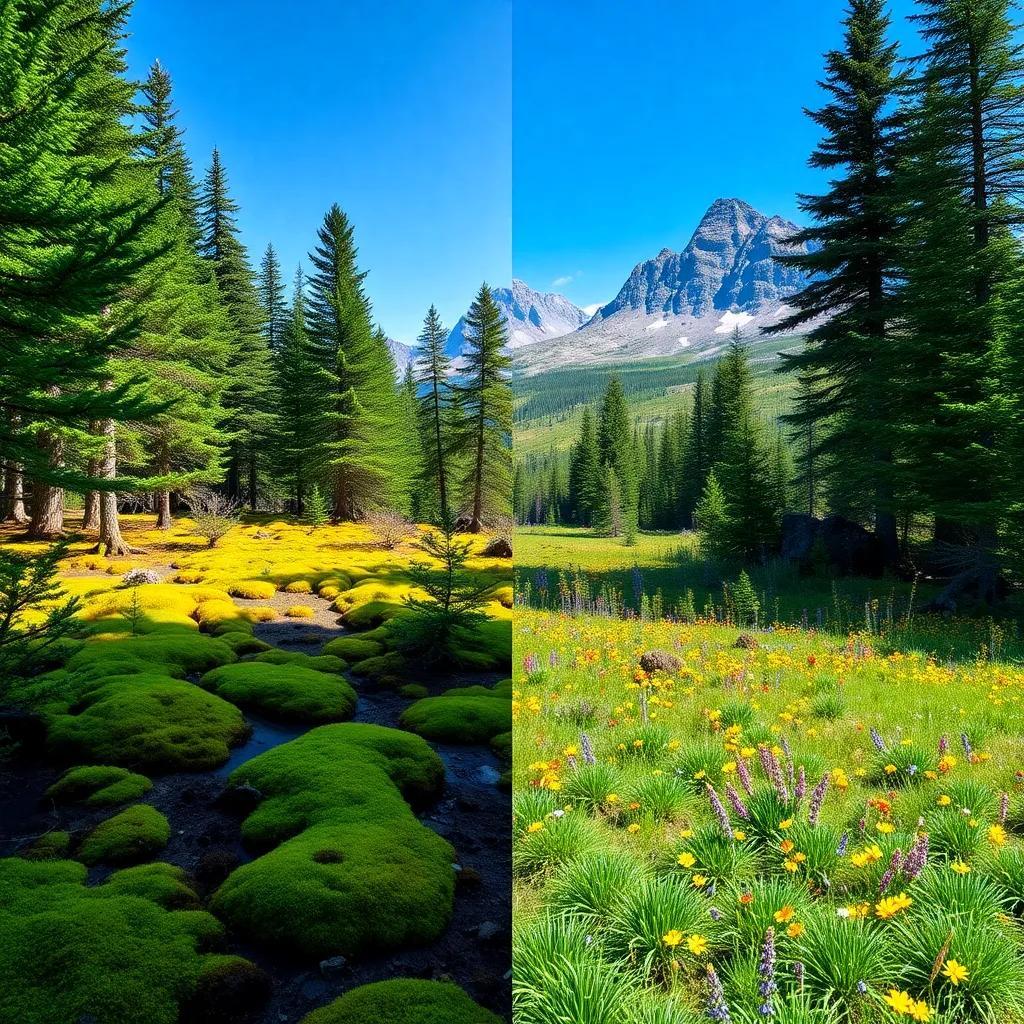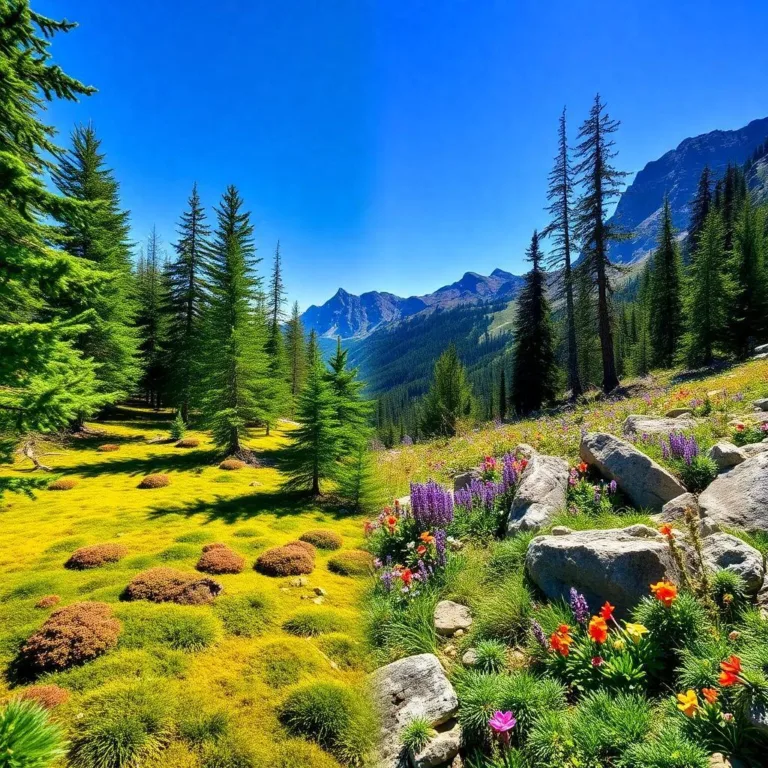Have you ever wondered how the ground cover changes as we move from the chilly boreal forest to the majestic Rocky Mountains? In this article, I’ll take you on a journey through two incredible ecosystems, showing you the unique plants and factors that shape their landscapes! Let’s uncover the secrets of nature together—get ready for a fun exploration!
Boreal Forest: Unique Characteristics and Ground Cover Types
The boreal forest, sometimes called the taiga, is truly one of nature’s wonders! Spanning across North America, Europe, and Asia, it’s the largest land biome on Earth. Can you believe it? I always find it fascinating how much life can thrive in such a cold environment!
In this enchanting forest, you’ll find a rich array of coniferous trees like spruce, fir, and pine. These trees are specially designed to handle the cold with their needle-like leaves that help them save water. But what about what’s happening on the ground? Well, the ground cover here is just as special!
Here are some key players in the boreal forest ground cover:
- Mosses: These little green softies are fantastic at holding onto moisture. They create a cozy blanket on the forest floor!
- Lichens: This cool duo of fungi and algae often grows on trees and rocks. They love the cold, and guess what? They’re a tasty treat for reindeer!
- Understory shrubs: Plants like willow and alder offer food and shelter for birds and small mammals. It’s like they’re hosting a buffet for their forest friends!
- Peatlands: These wet areas might seem a bit mucky, but they’re essential! They keep carbon locked away and help regulate water levels in the environment.
Knowing these elements helps me appreciate how delicate and balanced this ecosystem is. Each part plays a role, supporting all the different species that call the boreal forest home!
Ground Cover in the Rocky Mountains: Diversity and Adaptations
Ah, the Rocky Mountains! If you’ve ever hiked here, you know it’s breathtaking! Stretching over 3,000 miles, this majestic range is not just about stunning views; its ground cover is incredibly diverse too!
As we rise in elevation, the landscape changes dramatically. At lower altitudes, you’ll see a variety of grasses and hardy shrubs. Common sights include:
- Sagebrush: This resilient shrub loves the sunshine and provides shelter for small critters.
- Juniper: Another familiar sight, which adds a splash of greenery against the rocky backdrop!
Climbing up the mountains, the ground cover transitions to alpine meadows. Imagine colorful wildflowers splashed across the landscape! Here’s what makes them unique:
- They host a vibrant mix of sedges and various grasses that bloom during the short growing season.
- These meadows are buzzing with life! Pollinators like bees and butterflies can’t resist the feast of flowers.
Going even higher, we find the subalpine forests. These forests are filled with conifers like spruce and fir. They don’t just look pretty; they’re built to handle harsh conditions!
At the very top, above the tree line, the alpine tundra takes over. The ground cover includes:
- Lichens: Just like in the boreal forest, they thrive up here too.
- Cushion plants: These little champs have adapted to survive in extreme weather!
Every layer of the Rockies tells a story of nature’s adaptability! It’s amazing to see how life evolves based on elevation and climate. Each unique ground cover not only shapes the landscape but supports countless species! So, the next time you gaze at the Rockies, remember, there’s a whole world of diversity right beneath your feet!

Key Factors Influencing Ground Cover Changes
There are several fascinating reasons why ground cover changes between the boreal forest and the Rocky Mountains. Understanding these factors helps me appreciate the beauty and complexity of these ecosystems! Here are the primary influences you should know:
- Altitude: As you climb higher in the Rocky Mountains, the temperature drops! This means that the types of plants can change dramatically. Lower elevations have more moisture, allowing lush forests to thrive, while higher areas face harsher conditions, creating a more sparse and rocky landscape.
- Climate: The boreal forest and the Rockies experience different climates. The boreal forest has long, cold winters with very short summers, perfect for coniferous trees! The Rocky Mountains, however, boast a mix of climates due to their varying elevations, leading to diverse plant life that adapts to their unique surroundings.
- Soil Composition: The ground cover also depends on the soil. In the boreal forest, the soil is usually acidic and low in nutrients. This lack of nutrients influences the kinds of plants that thrive there—mainly mosses and lichens. In the Rockies, the soil changes depending on elevation. Higher up, the soil can be thin and rocky, which limits plant growth!
- Vegetation Dynamics: Different plants compete for resources like water, sunlight, and nutrients. In the boreal forest, tall coniferous trees dominate, casting shade on the forest floor. This shade restricts other plants from growing, allowing mosses and lichens to flourish. In contrast, the Rockies have a variety of plants at different heights due to their diverse habitats, allowing a greater variety of life at each level.
Understanding these factors helps me see how both ecosystems adapt to their unique environments! They are like two different recipes, each with distinct ingredients, that together create a delicious dish of biodiversity!
Comparative Analysis of Boreal Forest and Rocky Mountain Ground Cover
Let’s take a moment to compare the ground cover of the boreal forest and the Rocky Mountains. Both ecosystems boast rich plant life, but they are quite different in many ways! Here’s what I’ve noticed:
Ground Cover Composition
- Boreal Forest: This ecosystem is primarily covered in moss, lichens, and understory shrubs. The dense growth of coniferous trees provides shade, which makes it perfect for these ground-hugging plants to thrive. It’s like a cozy green carpet!
- Rocky Mountains: Here, the ground cover varies with altitude. At lower elevations, you’ll find grasses and hardy shrubs. As you rise, vibrant alpine meadows take center stage, bursting with colorful wildflowers, before transitioning to subalpine forests and finally to the alpine tundra with its sparse vegetation.
Biodiversity
- Boreal Forest: This forest has a rich biodiversity of animals that rely on the specific ground cover. For example, many birds and small mammals find shelter and food among the shrubs and mosses. It’s like nature’s own food court!
- Rocky Mountains: This region is known for its diverse wildlife too! Various plants support different animals, from grazing bighorn sheep in the meadows to black bears foraging near berry bushes. Each plant plays a role in the larger food web!
Soil and Nutrients
- Boreal Forest: The acidic soils here limit the variety of plants. However, the abundant peatlands are fantastic for carbon storage and provide essential nutrients for the plants that do grow.
- Rocky Mountains: The soil is more varied, ranging from rich and fertile at lower elevations to rocky and nutrient-poor at higher altitudes. This variation influences what plants can survive, creating a tapestry of life!
Overall, the differences in ground cover between these two breathtaking ecosystems illustrate the unique adaptations and survival strategies of plants and animals. They each thrive in their own way, making our planet so wonderfully diverse!
Ecological Significance of Ground Cover in Both Ecosystems
The ground cover in both the boreal forest and the Rocky Mountains plays a vital role in maintaining the health of these ecosystems! I find it amazing how everything is interconnected! Here’s why ground cover is so significant:
- Habitat Creation: Ground cover provides a home for various species. In the boreal forest, the thick layer of mosses and lichens offers shelter to small mammals and birds. The shrubs provide food and nesting spots! In the Rocky Mountains, alpine meadows are important for pollinators, which helps the entire ecosystem thrive.
- Water Regulation: Ground cover helps manage water levels! In the boreal forest, mosses retain moisture, playing a key role in regulating the water cycle. This is crucial for preventing flooding and ensuring that nearby plants have sufficient water during dry periods! Similarly, in the Rockies, plants in the meadows and forests soak up water and help maintain healthy waterways.
- Soil Stability: Plants in both ecosystems help anchor the soil, preventing erosion. Their roots hold the dirt in place, especially in the rocky terrain of the Rockies! This is super important, as erosion can lead to habitat loss and degraded landscapes.
- Carbon Storage: Ground cover in both environments contributes to carbon storage! Peatlands in the boreal forest are particularly effective at sealing away carbon, which helps combat climate change. The plant life in the Rockies also captures carbon, playing a part in regulating the atmosphere.
In essence, ground cover is like the unsung hero of these ecosystems! It supports biodiversity, regulates water, stabilizes soil, and fights climate change. Each time I think about it, I realize how important it is to protect these natural treasures for future generations! So, let’s cherish and conserve these incredible environments!

